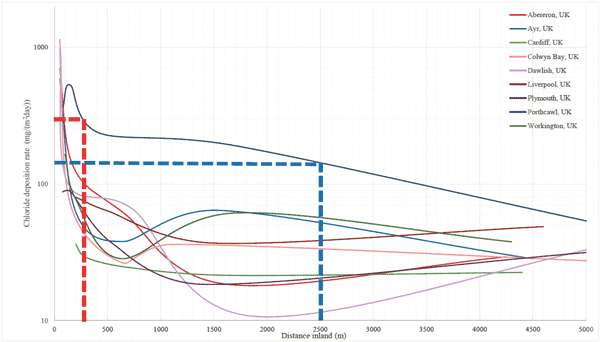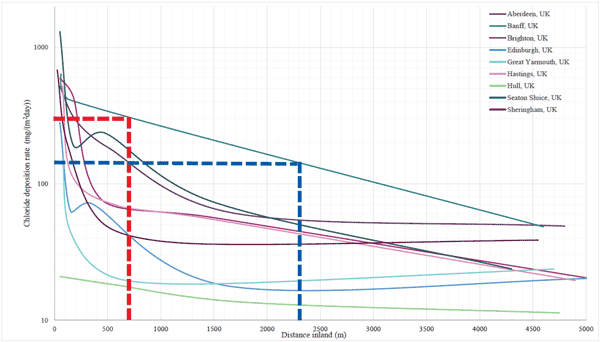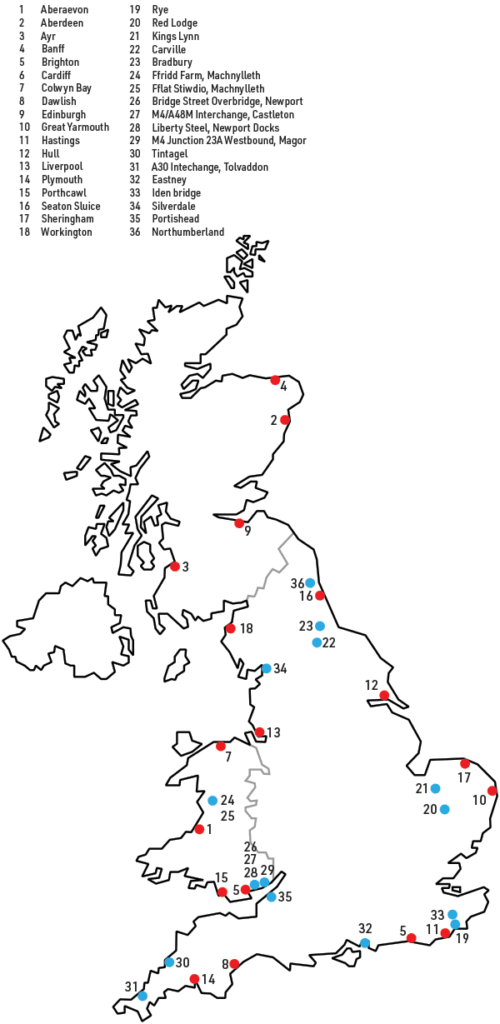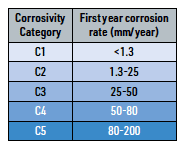Projects and Features
Atmospheric corrosivity classifications for weathering steel
Weathering steel has an increased resistance to atmospheric corrosion, compared to conventional steel, and a distinctive appearance which make it attractive for use in bridges. However, the decision to specify weathering steel in bridge projects often depends on the environmental conditions and more specifically on the proximity of a bridge to the coast. In the UK, corrosivity testing in accordance with BS EN ISO 9223 for a minimum of 12 months is mandatory at distances of less than 15 km from the coast. Typically, UK procurement routes do not give adequate time to undertake and assess the results of this testing. In other countries testing may be required in specific situations.
This article discusses the findings of a study commissioned by SCI’s Steel Bridge Group and carried out by Arup[1]. The objective of the study leading to this article was to provide an evidenced based approach for the classification/assessment of environments and propose scientifically justified limitations on the use of weathering steel in bridges (or requirements for site specific corrosivity testing) within a certain distance from the coast for the UK.
Introduction
Weathering steel is a low-alloy steel that under normal atmospheric conditions gives an enhanced resistance to corrosion compared with that of ordinary carbon manganese steel. Weathering steel is specified to BS EN 10025-5[2] and has similar mechanical properties to conventional steel. In the presence of moisture and air, a rust layer is formed that adheres to the base metal due to the specific alloying elements used in the manufacturing process. This rust ‘patina’, which develops under conditions of alternate wetting and drying, acts as a protective barrier, impeding further access of oxygen, moisture and contaminants and effectively reducing the rate the steel corrodes.
Weathering steel bridges are generally suitable for use in most locations. However, as with other forms of construction, there are certain environments which can lead to durability problems. The performance of weathering steel in such extreme environments as marine environments and/or environments with very high levels of atmospheric pollution may not be satisfactory, and this should be considered.
Exposure to high concentrations of chloride ions, originating from sea water spray, salt fogs or coastal airborne salts, is detrimental. The hygroscopic nature of salt adversely affects the ‘patina’ as it maintains a continuously damp environment on the metal surface.
The scope and outcomes of the investigation leading to this article are summarised below:
- UK and international standards and guidance on the use of weathering steel near the coast was assessed.
- Data on chloride deposition with distance from the coast including those from ISOCORRAG[3] program, EUR 7433 Report[4], site specific test data and other relevant sources were collated.
- Available site-specific data were reported on a map and data were plotted as curves for a range of UK locations.
- The overall corrosivity of UK sites (based on categorisation of BS EN ISO 9223[5]) at increasing distances from the coast was estimated.
The methodology, data sets, plots and recommendations are reported in the following paragraphs.
Review of standards and international guidance
Weathering steel is widely used for bridge fabrication in the UK, continental Europe, North America, Australia, and New Zealand. Highway and Rail authorities in these countries have standards and guidance relevant to the use of weathering steel. The standards and guidance cover all aspects of steel fabrication, but this article only considers those parts relevant to durability and the potential need for assessment when a bridge is located near the coast. A summary of the requirements and limitations on the use of weathering steel in bridges in the UK, Germany, France, North America, Australia, and New Zealand is presented in Table 1.
Chloride deposition data in the UK
The presence of chloride ions on the surface of steels increases the risk of corrosion. Chlorides are deliquescent and will absorb moisture from the atmosphere. This increases the time of wetness on the surface and the total period when corrosive processes are active. Chloride ions are present in natural water sources (particularly the oceans) and are made airborne by a combination of wave action and the wind blowing over the water. Airborne chlorides are then transported to and can deposit on surfaces at distance from the source.
A research report published in 1981 by the European Commission (EUR 7433[4]), summarises the results of a joint research project to provide directives for selection of atmospheric corrosion test sites and collect environmental data on the maritime atmospheric environment. Among other data presented, the chloride deposition rates were measured at 36 sites across Europe up to 5 km inland from the coast, 18 of these sites were in the UK. The aim of this element of the research was to gain an understanding of how rapidly the airborne salinity decreases with increasing distance from the coast.
Airborne salinity was monitored monthly using the wet candle method (the method now used in BS EN ISO 9225[11]) over a period of two years. The data from the EUR 7433 report[4], plotted as a line graph, shows the measured values for the chloride deposition rates at increasing distance from the coast. Figure 1 and Figure 2 show the data for UK sites split into those that fall west and east, respectively, of a central line of the UK. Lines in blue and red show the distance at which the chloride deposition rate falls below 150 and 300 mg/(m².day), respectively.


Some chloride deposition data points from EUR 7433[4] are higher/lower than expected at specific sites. These anomalies are caused by site specific conditions which affect the local (micro) environment at the measured distance. As an example, the chloride deposition may be lower than expected due to the monitoring site being in a sheltered location (by vegetation or adjacent buildings). Another example is the data presented in Figure 2 for Banff, which show that the chloride deposition varies linearly (as opposed to the exponential trend typically seen) between 150 and 4600 m and this is because no site monitoring took place between these points for the specific case.
Further site-specific chloride deposition data has been obtained from different data sources which include:
- Transport and Road Research Laboratory (TRRL) report[12] on ‘The corrosion performance of weathering steel in highway bridges’ published in 1978, in which corrosivity assessments were carried out for weathering steel at various locations across the UK.
- ISOCORRAG ‘International Atmosphere Exposure Program’[3], which formed the basis of BS EN ISO 9223 standard.
- Project specific data from previous Arup projects in the UK.
This data was found to sit within the extremes of the data reported in the EUR 7433 report[4] for the UK sites which was plotted in Figures 1 and 2.
The plots in Figure 1 and Figure 2 show that air-borne chloride deposition decreases with distance from the coast:
- At 200 m inland the chloride deposition rates are less than the limit defined in BS EN ISO 9223 for an S3 category.
- At 2500 m inland the chloride deposition rate falls below 150 mg/m².day.
- Beyond 2500 m from the coast the deposition rate continues to decay.
All the data demonstrate that chloride deposition rates rapidly decrease with increasing distance from the coast. At < 2500 m inland, the chloride deposition rate is less than half that of the criteria given in DMRB CD 361[6].
Overall corrosivity of UK sites
Methodology
The atmospheric corrosion assessment for several UK sites was done according to BS EN ISO 9223[5], which uses data and statistical models developed as part of a global corrosion study to estimate corrosion rates. The ISOCORRAG study[3] used standardised samples and measurement methods to estimate corrosion rate over time and correlated those rates with environmental parameters. Corrosion rates were evaluated by weight loss at annual intervals. Samples were exposed at sites around the world.
The BS EN ISO 9223 standard is concerned with the classification of corrosivity of atmospheres based on the first-year corrosion rate for various metals. Such classification requires twelve-month exposure of relevant test specimens. The standard also includes other methodologies to estimate atmosphere classification, i.e. with\out a twelve-month exposure trial. In this report, estimation of corrosivity uses a semiquantitative interpretation of the BS EN ISO 9223 Dose Response Function (DRF) using environmental input parameters.
Four environmental parameters are used to assess likely corrosion rates:
- Average annual air temperature (T)
- Average annual relative humidity (RH)
- Average annual deposition rate for sulphur dioxide (Pd)
- Average annual deposition rate for chloride (Sd)
These parameters permit the estimation of a corrosion rate for the first year of exposure using a statistical model specified in BS EN ISO 9223. An additional environmental parameter to consider is wind direction. Wind influences the transport and deposition rate of sulphur dioxide and chlorides. Where site specific values for these are not known, the wind data can be used in predicting likely exposures.
The methodology provides an overall, or macro, assessment of corrosion risk based on the general corrosion rate i.e. uniform loss of section over the surface exposed to the natural environment. There is a degree of uncertainty associated with the estimation of atmospheric corrosivity, which BS EN ISO 9223 estimates as – 33% and +50% for zinc, carbon steel and copper, and -50% and +100% for aluminium. The corrosion rate calculated in accordance with BS EN ISO 9223 assumes uniform corrosion.
Site locations
The 36 sites considered are shown in Figure 3. Those in red are from EUR 7433[4] and those in blue are from the TRRL report[12], ISOCORRAG[3] and other project specific reports.
Average annual temperature and relative humidity
The BS EN ISO 9223 standard uses annual average temperature and humidity as its temperature and humidity parameter. The average annual temperature and relative humidity for the sites considered was obtained from UK Met Office[13] where climate averages over a rolling 30-year period with the most recent averaging period being 1991-2020 are reported.
Average annual deposition rate for sulphur dioxide
Historically, the most common source of SO₂ emissions were from coal fired power plants, refineries, heavy industry, vehicle exhaust emissions and shipping in ports. Following UK and European emission control legislation in the late 20th Century atmospheric SO₂ concentrations have dramatically declined in recent decades. DEFRA routinely collected sulphur dioxide concentrations in the air in various parts of the UK until circa 2005 when the concentrations had declined to concentrations that were nearly undetectable with the conventional measurement technique. It was recommended as a result that the measurements ceased.
SO2 deposition rates were used from monitoring data where possible. When data was not available, sites were qualitatively assessed for any nearby SO2 sources and SO2 deposition was defined based on the relative distance, topology and wind direction. In general, for sites near ports, harbours and industrial facilities an upper bound urban atmosphere (P1) was conservatively assumed. Sites located in urban areas with no nearby SO2 sources, were classified on the boundary of a rural (P0) and urban (P1) atmosphere. Rural areas assumed a lower bound rural (P0) atmosphere, the value of which is defined by the Dose Response Function equation. BS EN ISO 9223 groups pollution by sulphur dioxide into four categories (P0 to P3).
Average annual deposition rate for chlorides
The average annual chloride deposition for the assessed sites at distances of 300 to 5000 m were obtained from the EUR 7433 data[4]. At 5000 m and greater the chloride deposition has fallen to S1 category of BS EN ISO 9223.
Atmospheric corrosion assessment
BS EN ISO 9223 provides a model that uses the location and the previously mentioned environmental parameters (temperature/humidity and deposition rates for sulphur dioxide and chlorides) to estimate the corrosion rate at a site for the first year of exposure, by use of a statistical dose response function. The first-year corrosion rate also defines the site’s corrosivity category.
BS EN ISO 9223 groups corrosion rates into a series of corrosivity categories that reflect the severity of the exposure environment, as shown in Table 2.
Using the location and environmental data collected for each site, the corrosion rate for UK sites was estimated for distances of 300, 1000, 2500, 5000, 10000 and 15000 m inland, with the corresponding corrosivity category. This is plotted in Figure 4, conservatively adding 50% uncertainty in the calculation.
As shown in Figure 4, C5 corrosivity categories only occur at sites of very short distances from the coast (< 2 km, and in the majority of cases < 0.5 km to 1 km) and C4/C3 at > 2 km conservatively assuming 50% uncertainty in the calculations.

Conclusions
1) Review of international guidance on the use of weathering steel shows the UK approach to requirements for testing for both salinity and corrosivity is conservative.
2) All data indicates that air borne salinity, measured as dry deposition to BS EN ISO 9225, decays rapidly with distance from coast. At a distance of 2.5 km inland from the coast the deposition rate is less than half the S3 value. At distances greater than 2.5 km inland from the coast the chloride deposition continues to decay. These conclusions are supported by site specific data measured in accordance with BS EN ISO 9225 at various distances inland from the coast.
3) Estimation of corrosivity categories with distance from the coast, using the equation for carbon steel given in BS EN ISO 9223, show the highest corrosivity class (C5) only occurs very close to the coast (< 2 km) and that within a short distance, typically 1 km, the corrosivity category is generally C3 or in some cases C4, where the +50% uncertainty is included in the estimation of loss.
4) The data provides evidence that full corrosivity testing using coupons and salinity testing should be a mandatory requirement only if the proposed structure is less than 2.5 km from the coastline.
In addition to the findings and conclusions of the study reported above, the Steel Bridge Group has been gathering data from its members and from bridge owners on the performance of weathering steel bridges that have previously been constructed within 15 km of the UK coastline. This data is being added onto an online map[14]. This data suggests that existing weathering steel bridges are performing well, and where problems have been encountered they were not significant and they have been the direct result of poor detailing and specific faults such as leaking deck joints, rather than any general inadequacy in corrosion performance.
References
- Sangster M., Frydman B. and Gedge G., UK Atmospheric Corrosivity Classifications for Weathering Steels. Technical report to the Steel Construction Institute and the Steel Bridge Group. Arup, January 2023.
- BS EN 10025-5:2019, Hot rolled products of structural steels – Technical delivery conditions for structural steels with improved atmospheric corrosion resistance, BSI.
- Knotkova D., Kreislova K. and Dean S.W., ISOCORRAG international atmospheric exposure program: summary of results, ASTM International, 2010.
- Johnson K. and Stanners J., The characterisation of corrosion test sites in the community, EUR 7433, Commission of the European Communities, Directorate – General Information Market and Innovation, 1981.
- BS EN ISO 9223:2012, Corrosion of metals and alloys. Corrosivity of atmospheres. Classification, determination and estimation, BSI.
- Design Manual for Roads and Bridges CD 361, Weathering steel for highway structures (formerly BD 07/01), Revision 0.
- European Convention for Constructional Steelwork (ECCS), European design guide for the use of weathering steel in bridge construction, 2nd Edition, 2021.
- National Bridge Alliance, Uncoated weathering steel reference guide. American Institute of Steel Construction (AISC), 2022.
- El Sarraf R., Mandeno W.L. and Hicks S., Weathering steel – Design guide for bridges in Australia. Bluescope Steel Ltd, 2017.
- El Sarraf R., Mandeno W.L. and Karpenko M., New Zealand weathering steel guide for bridges.
HERA, 2020. - BS EN ISO 9225:2012, Corrosion of metals and alloys. Corrosivity of atmospheres. Measurement of environmental parameters affecting corrosivity of atmospheres, BSI.
- McKenzie M., The corrosion performance of weathering steel in highway bridges, Transport and Road Research Laboratory, 1978.
- UK climate averages, Met Office, [Online]. Available: https://www.metoffice.gov.uk/research/climate/maps-and-data/uk-climate-averages [Accessed 28 November 2022].
- Interactive Map with weathering steel bridges in the UK built close to the coast, The Steel Bridge Group, [Online]. Available: https://www.google.com/maps/d/viewer?mid=1IM5qC6l5f6faojiihjYGvlzYMh8RqAnd&safe=active&ll=54.53943956067122%2C-1.771182404429652&z=6.
















